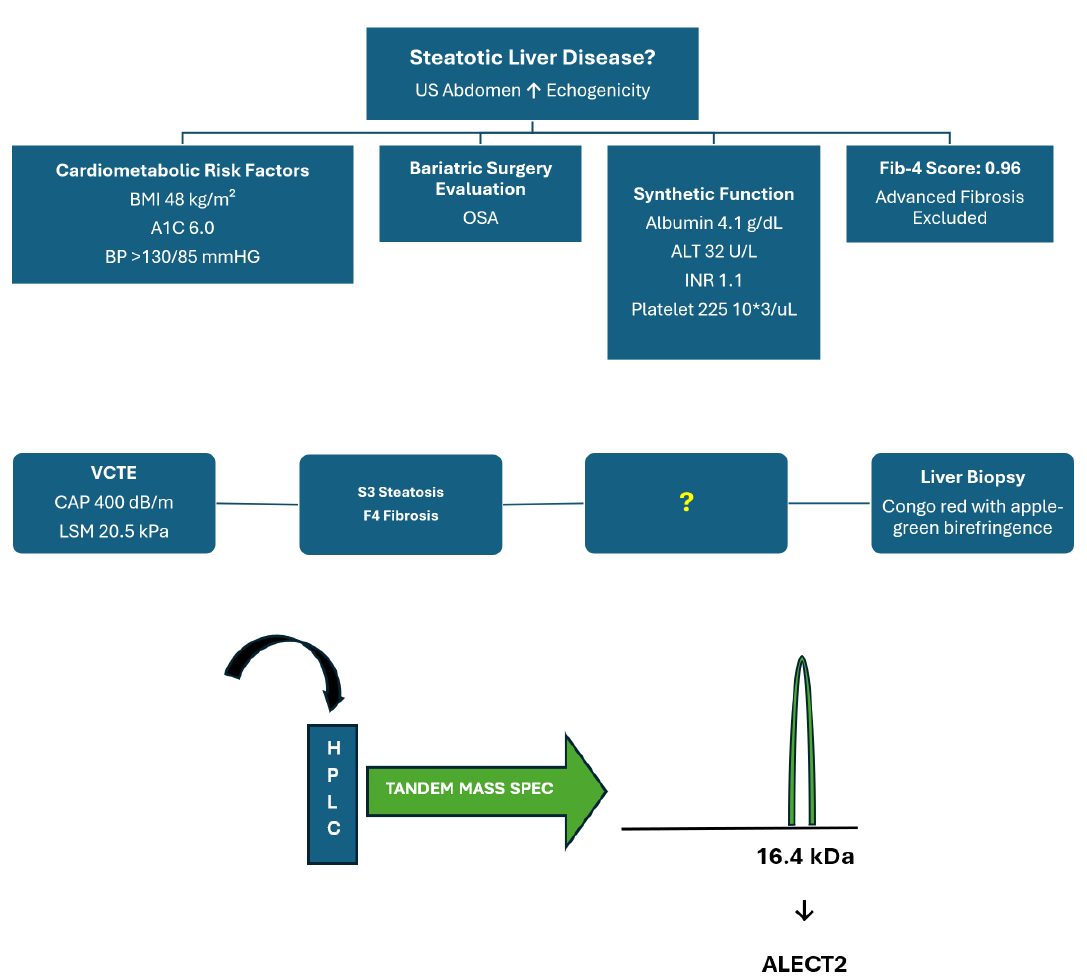Sunday Poster Session
Category: Liver
P1794 - Silent Amyloidosis: Incidental Discovery of ALECT2 Amyloidosis in a Patient With Metabolic-Associated Steatotic Liver Disease
Sunday, October 26, 2025
3:30 PM - 7:00 PM PDT
Location: Exhibit Hall

Katherine Jones, DO
University of California San Francisco (Fresno)
Fresno, CA
Presenting Author(s)
Hunza Chaudhry, MD1, Muhammad B. Hammami, MD2, Katherine Jones, DO1
1University of California San Francisco, Fresno, CA; 2UCSF Fresno, Fresno, CA
Introduction: Amyloidosis is characterized by the inappropriate deposition of misfolded proteins in tissues. Leukocyte chemotactic factor 2 (ALECT2) amyloidosis is a distinct subtype that predominantly affects the kidneys and liver, though it remains underrecognized. Hepatic involvement of this amyloid protein can mimic metabolic-associated steatotic liver disease (MASLD), complicating its diagnosis. We present a case of incidental ALECT2 amyloidosis identified during an intraoperative liver biopsy in a patient undergoing sleeve gastrectomy for obesity.
Case Description/
Methods: A 58-year-old man with class III obesity, prediabetes, dyslipidemia, and obstructive sleep apnea presented for gastric sleeve surgery. Preoperative abdominal ultrasound revealed an enlarged liver with diffuse increased echogenicity. Vibration-controlled transient elastography (VCTE) in demonstrated a Controlled Attenuation Parameter score of 400 dB/m and a liver stiffness measurement of 20.5 kPa (IQR/Med 13%), consistent with S3 steatosis and F4 fibrosis. Laboratory results were largely unremarkable, including normal liver-associated enzymes, synthetic function (albumin, bilirubin, INR), and platelet count. Intraoperative liver biopsy revealed moderate steatosis without steatohepatitis, significant fibrosis, or duct-destructive lesions, overall inconsistent with recent VCTE findings. However, amorphous, globular deposits within the portal tracts stained positive for Congo red with apple-green birefringence. Liquid chromatography-tandem mass spectrometry confirmed ALECT2 amyloidosis. The patient recovered well post-surgery, achieved significant weight loss, and maintained normal liver and renal function after one year.
Discussion: ALECT2 amyloidosis is a rare condition that can mimic common liver diseases, such as MASLD, particularly in patients with metabolic risk factors. Here, the degree of liver fibrosis on VCTE was inconsistent with the biopsy findings and further investigation led to the diagnosis of ALECT2 amyloidosis. Although no specific treatments are currently available, early recognition of this condition is crucial for managing disease progression and preventing organ-specific complications. This case underscores the importance of considering rare conditions like ALECT2 amyloidosis in the differential diagnosis of liver disease, especially in high-risk populations. Further research is needed to identify at-risk populations and develop diagnostic and management guidelines for this rare condition.

Figure: Figure 1. Incidental Diagnosis of ALECT2 during Sleeve Gastrectomy for Obesity and MASLD
Disclosures:
Hunza Chaudhry indicated no relevant financial relationships.
Muhammad B. Hammami indicated no relevant financial relationships.
Katherine Jones indicated no relevant financial relationships.
Hunza Chaudhry, MD1, Muhammad B. Hammami, MD2, Katherine Jones, DO1. P1794 - Silent Amyloidosis: Incidental Discovery of ALECT2 Amyloidosis in a Patient With Metabolic-Associated Steatotic Liver Disease, ACG 2025 Annual Scientific Meeting Abstracts. Phoenix, AZ: American College of Gastroenterology.
1University of California San Francisco, Fresno, CA; 2UCSF Fresno, Fresno, CA
Introduction: Amyloidosis is characterized by the inappropriate deposition of misfolded proteins in tissues. Leukocyte chemotactic factor 2 (ALECT2) amyloidosis is a distinct subtype that predominantly affects the kidneys and liver, though it remains underrecognized. Hepatic involvement of this amyloid protein can mimic metabolic-associated steatotic liver disease (MASLD), complicating its diagnosis. We present a case of incidental ALECT2 amyloidosis identified during an intraoperative liver biopsy in a patient undergoing sleeve gastrectomy for obesity.
Case Description/
Methods: A 58-year-old man with class III obesity, prediabetes, dyslipidemia, and obstructive sleep apnea presented for gastric sleeve surgery. Preoperative abdominal ultrasound revealed an enlarged liver with diffuse increased echogenicity. Vibration-controlled transient elastography (VCTE) in demonstrated a Controlled Attenuation Parameter score of 400 dB/m and a liver stiffness measurement of 20.5 kPa (IQR/Med 13%), consistent with S3 steatosis and F4 fibrosis. Laboratory results were largely unremarkable, including normal liver-associated enzymes, synthetic function (albumin, bilirubin, INR), and platelet count. Intraoperative liver biopsy revealed moderate steatosis without steatohepatitis, significant fibrosis, or duct-destructive lesions, overall inconsistent with recent VCTE findings. However, amorphous, globular deposits within the portal tracts stained positive for Congo red with apple-green birefringence. Liquid chromatography-tandem mass spectrometry confirmed ALECT2 amyloidosis. The patient recovered well post-surgery, achieved significant weight loss, and maintained normal liver and renal function after one year.
Discussion: ALECT2 amyloidosis is a rare condition that can mimic common liver diseases, such as MASLD, particularly in patients with metabolic risk factors. Here, the degree of liver fibrosis on VCTE was inconsistent with the biopsy findings and further investigation led to the diagnosis of ALECT2 amyloidosis. Although no specific treatments are currently available, early recognition of this condition is crucial for managing disease progression and preventing organ-specific complications. This case underscores the importance of considering rare conditions like ALECT2 amyloidosis in the differential diagnosis of liver disease, especially in high-risk populations. Further research is needed to identify at-risk populations and develop diagnostic and management guidelines for this rare condition.

Figure: Figure 1. Incidental Diagnosis of ALECT2 during Sleeve Gastrectomy for Obesity and MASLD
Disclosures:
Hunza Chaudhry indicated no relevant financial relationships.
Muhammad B. Hammami indicated no relevant financial relationships.
Katherine Jones indicated no relevant financial relationships.
Hunza Chaudhry, MD1, Muhammad B. Hammami, MD2, Katherine Jones, DO1. P1794 - Silent Amyloidosis: Incidental Discovery of ALECT2 Amyloidosis in a Patient With Metabolic-Associated Steatotic Liver Disease, ACG 2025 Annual Scientific Meeting Abstracts. Phoenix, AZ: American College of Gastroenterology.
